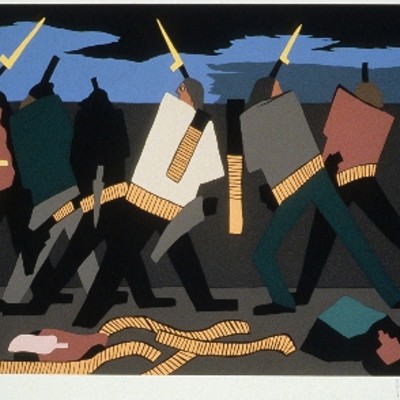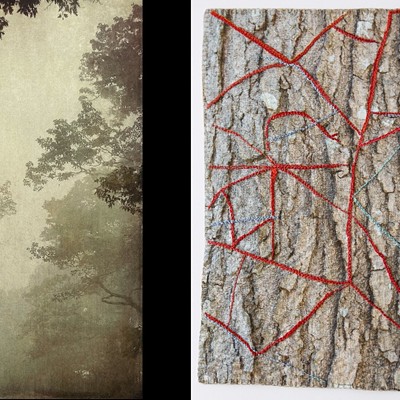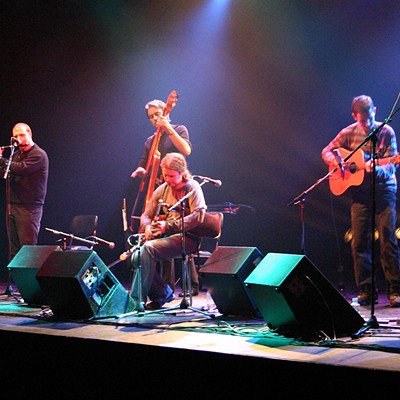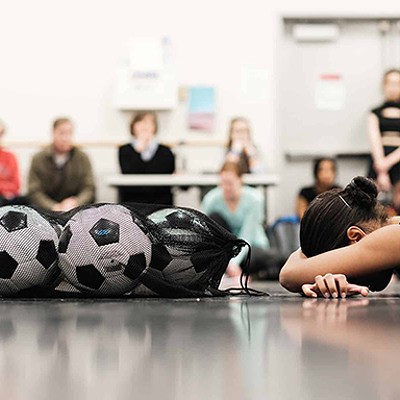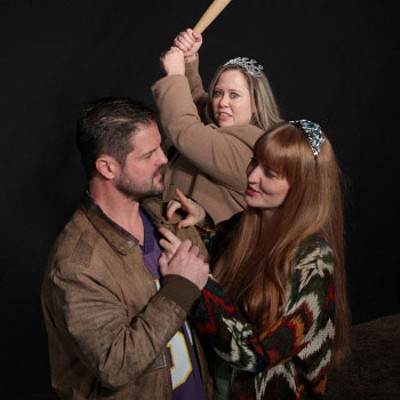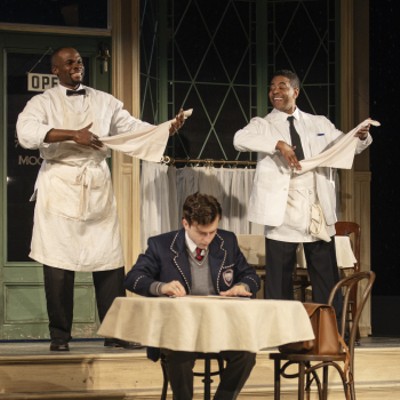What does an extinct frog sound like?
If you turn up the volume on Tracy Hicks' "Canaries/Frogs/Silence" at the Tucson Museum of Art, you'll find out: it croaks and squeaks and trills. A chorus of the voices of lost frog species—"the sounds of frogs that no longer exist," as curator Julie Sasse put it—is the haunting soundtrack for Hicks' mixed-media installation.
Texas artist Hicks assembled "Canaries" specifically for Sasse's big show Trouble in Paradise: Examining Discord Between Nature and Society. Re-creating a piece of a work he exhibited in Dallas last year, the artist converted a whole wall of the museum into a simulated ecology lab. Shelves are jumbled with test tubes lit by colored lights and glass jars filled with silicon casts of endangered frogs. The frog replicas float inside the glass, appearing as dead as the frog cousins whose croaking resounds through the air.
Hicks isn't just an artist with a frog fixation. He breeds endangered frogs and toads at home, and he's gone to South America with herpetologists on a frog-research expedition.
The artist inscribed some of his data on the museum wall in pencil. A chart divided by years shows the small number of frog species that disappeared in the years between Linnaeus and Darwin, with short scattered lines indicating intermittent loses. But the number escalates rapidly following Darwin, and the small lines give way to thickly clotted slashes signifying catastrophic species death.
Like the proverbial canary in the mine, the disappearing frogs are signal species, raising alarms about climate change and habitat destruction. Sasse's show, a major undertaking seven years in the making, takes a look at environmental catastrophe through the prism of art. Photography makes the strongest showing, but multiple media are represented, including the traditional arts of painting and drawing, as well as up-to-the minute videography and installation. Frying pans even debut as a poignant art medium.
At least three pieces, including Sue Coe's graphite drawing "We Are All in the Same Boat," rework Gericault's 1819 shipwreck painting "The Raft of the Medusa" as an image of impending doom.
"At first, I was looking at death as part of the lifecycle," Sasse said, "but then all these natural disasters occurred: the tsunami, Hurricane Katrina, global warming. This stuff was too powerful to leave out."
So the show shifted. For sure, its 60 artworks by 57 artists from eight countries seemingly include every possible natural disaster, from floods and tornadoes to lightning storms and tidal waves. Daredevil Tucson lightning chaser Jeff Smith shows a dazzling 2003 photo, "Red Rock Power Station, Arizona." A jagged white bolt flashes against a violet sky and darts down between power towers etched in black. In Susan Shatter's 1992 "Volcano," an egg tempera painting on wood, fiery orange lava spews skyward. Anthony Pessler conjures a terrifying tornado on the prairie in black and white in "Sturm und Drang," a 2008 graphite drawing.
Scary as these eruptions are, Sasse argues through her exhibition that the greatest natural disasters arise out of human cupidity and stupidity. Most of the artists, like Hicks, are looking at problems caused by homo sapiens. Destroy your rain forest, and you kill your frogs. Slice off the prairie grasses, and you get the Dust Bowl. Burn fossil fuels, and you push up global temperatures and melt the icepacks. Fill in the wetlands of the Mississippi, and the waters of Hurricane Katrina have no place to go but the Ninth Ward.
Several arresting works capture the human catastrophe of Katrina. Renowned photographer Robert Polidori shot a desolate New Orleans bedroom. Once sumptuous, "6328 North Miro Street," 2005, is covered in fine gray mold and debris. The empty bed is collapsed. Mitch Epstein caught a mattress in a dead tree in "Biloxi, Mississippi," 2005.
Luis Cruz Azaceta, a Cuban transplanted to New Orleans, combined the homely belongings of the exiles with pictures in "At the Bottom of the Pot," 2007. He roamed his adopted city after the flood, collecting pots and pans that had floated away from kitchens. He hung 40 of the pots in a grid on the museum walls, and glued onto the back of each one a photo of a flood victim—screaming, crying or dead.
Global warming and the decline of the polar bear get a humorous—sort of—treatment from Irish artist Nevan Lahart. "Ch. 91: The Sun Sets on Santa's North Pole Operation," 2007, is an oil and acrylic painting in Arctic black and white, crudely framed by wood tricked up to look like an old-style TV. Poor Santa has lost his habitat, and he's already dead, lying in a polar bear's lap like Jesus in the Pietà. The painting is racy and weird—Santa is naked and bleeding—and the presence of the TV suggests the role of the media in sensationalizing and trivializing. If it bleeds, it leads. Maybe a dead Santa is the only way to get climate change on the nightly news.
Mikhael Subotzky, a 28-year-old Magnum photog from South Africa, also draws on art history, beautifully, in his "Beaufort West," a large-format color photo from 2006. Trash pickers in a rubbish dump bend over plastic bags and food cups and cheap toys, curving their backs every bit as gracefully as "The Gleaners" picking up stray wheat in the 1857 Jean-François Millet painting. At least the grains the Frenchwomen were scavenging were healthful foods. The South Africans are scrounging through consumer trash, which extends across the landscape as far as the eye can see. But the artists in both cases sanctify the wretched of the Earth in their artworks: The desperate searchers are bathed in a heavenly light.
An angelic image by Australian Rosemary Laing of a flying woman, "weather #4," 2006, suggests a less-than-celestial event. Laing has photographed a doll in a white dress tumbling down out of the sky, surrounded by scraps of paper from newsmagazines. It suggests the falling bodies of Sept. 11. The piece strays a little from the theme, perhaps, since Sept. 11 was not (at first) an environmental disaster, but it is simply too powerful to be left out.
Closer to home, Tempe video artist Dan Collins, an Arizona State University professor, has conjured up Phoenix under water in the video installation "Flood," 2008-2009. Digital animation depicts Phoenix reincarnated as a sea, with its familiar mountains rising up fetchingly above the shining waters. Photos picture assorted alluring color shots of the watery city, with the tops of skyscrapers peeking above the waters. The piece is apparently intended as a serious look at possible flooding, but it's so inventive that it's just plain fun.
Heather Green of Tucson created another installation, hers taking a critical look at the Sea of Cortez, where overfishing by factory ships has caused a decline in fish populations and where overdevelopment is eroding the coastline. "Tide Cycle—An Act Against Erasure" appeared in the MFA show at the UA last year. (More power to Sasse for including an up-and-coming young artist alongside big names from around the world.)
The energetic Green uses every medium in her mix to drive home the point that you can't tamper with nature without consequences. Wonderful little oil paintings depict a red chair being carried out to sea by the relentless tides. Old-fashioned metal linotype "slugs" piled on pedestals below spell out the erosion problems and water shortages caused by all those condos going up in Puerto Peñasco. Tiny photos documenting the coming and going of the tides are arranged sequentially on giant viewfinders. You turn the crank to see the 24-hour cycle, with the waters shifting fetchingly by the light of the sun and the moon.
Her "Tide Cycle" is both an homage to the seaside paradise and a warning that it may already be a paradise lost.

